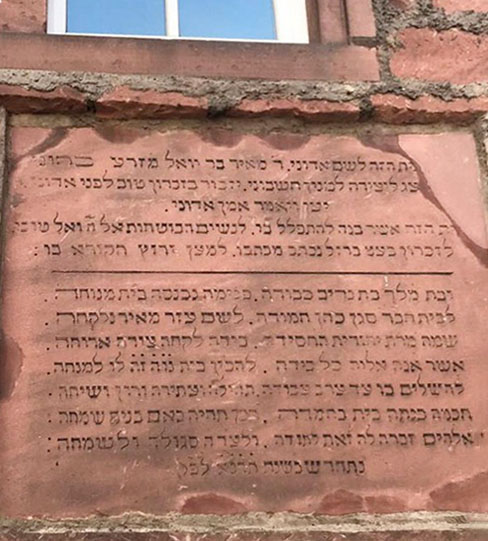The origin of the women’s section in the synagogue
Synagogue des Tournelle, Paris. The photo is part of a photography project of women’s galleries in synagogues by photographer Aviv Yitzhak
Published November 3, 2022
The Jewish sages founded the institution of the synagogue in the days before the Second Temple’s destruction. From the moment of its establishment, it faced a pressing issue: Could women pray there together with the men? And if so, how? Throughout Jewish history, from the destruction of the Temple to the present day a variety of approaches have been used to address this issue in various communities with diverse institutions and houses of prayer built accordingly.
The sages interpreted the biblical commandment “You shall teach them to your children, talking of them, when you sit in your house, and when you walk by the way, and when you lie down, and when you rise up” (Deuteronomy 11:19), to mean: “Your sons and not your daughters,” thereby exempting women from learning Torah. But others challenged this statement and objected to women being denied the ability to study Torah.
Unlike the issue of whether women should or should not study the Torah, there was never any question that it was the right and even the duty of every Jew—man or woman—to listen and take part in the prayer. It was generally accepted that the men lead the prayer and read from the Torah, while women are permitted to listen.
ADVERTISEMENT
The Days of Praying Together
The Mishnah and the Talmud are full of examples of women who regularly participated in prayer in public, by either reading from the Torah or listening to a sermon in the synagogue or study house. But where did the women congregate when they came to pray and listen? In this article we will try to locate the origins of the ezrat nashim, the women’s section or gallery in the synagogue.
When the synagogue was founded in the days of the Second Temple, there was no separate women’s section, nor any partition inside the physical structure. Therefore, according to the religious law of the time, women were required to sit and pray alongside the men. Today, in most Orthodox synagogues, the presence of women in the same prayer space as men would be viewed as inappropriate, but in the time of the great Jewish sages it was a routine occurrence.
The Jewish philosopher Philo of Alexandria told of synagogues in Alexandria where women and men prayed in the same hall, but in separate locations. Women’s participation in prayer was an agreed and accepted practice and was not even affected by the prohibition against women’s appearance in public (on the grounds of protecting their modesty).
ADVERTISEMENT
To be able to participate in prayer requires basic literacy. Documents in the Cairo Genizah show that women received a Jewish education at home and learned to read and write so that, among other things, they could take part in prayer. A girl’s father was responsible for her education, and in rare cases adult women tutored girls. Additional evidence from the Cairo Genizah shows that in medieval Egyptian society, women, especially Jewish women, were granted freedom of occupation and economic independence, with some even becoming rich. These wealthy women often contributed to the construction and renovation of synagogues and their upkeep, as well as financing oil for the lamps so that the worshipers could study at night.
From the Women’s Gate to the Women’s Gallery
So when did today’s familiar partitions first appear? It seems that for hundreds of years the term ezrat nashim, meaning women’s gallery, was not in use at all. The renowned scholar Shlomo Dov Goitein presented several sources from the Genizah dealing with the sha’ar nashim, the “women’s gate” in the synagogues of Egypt, proving that in the 11th century at the latest, special entrances were created for women through which they would go up to a gallery above the main hall, where they could then participate in prayer.
The term beit knesset nashim, “women’s synagogue,” first appeared among Ashkenazi Jews in the 12th century. But while the “women’s gate” in the synagogues in Egypt was an entrance to a gallery that separated the men from the women in the same space, the “women’s synagogue” in Ashkenaz was a physical structure separate from the “general” synagogue. The buildings were sometimes located at a distance from one another, but surprisingly, while the individual prayer services for men and the women were held in these separate locations, when the sermon began, the women would join the men in their hall and would either sit alongside them or a partition would be put up.
Apparently, the first exception to this rule was the synagogue in Worms in Germany. This synagogue was built in 1175, and a women’s gallery was added in 1213. An inscription on the wall of the building is the earliest evidence of the existence of a women’s gallery as a separate room in the synagogue next to the men’s section.

With the establishment of the “women’s synagogue” in the Middle Ages, a new creative world of women’s prayer flourished, featuring women poets, prayer leaders and cantors. The tombstone of one such Jewish woman, Ornea, daughter of the cantor Rabbi Abraham of Worms, who died in 1275, features the epitaph: “This headstone was erected for the lady Ornea, the exceptional and esteemed woman, daughter of Rabbi Abraham, chief of the poets, whose prayer was glory, who with a pleasant voice petitioned on behalf of his people, and she too in a sweet voice, sang hymns for women.”
Women such as Ornea, who were called sagerke and firsagerin in Yiddish, served as readers and poets who read or sang the words of the prayers for the illiterate in the women’s gallery.
Only in the 17th century were the practices that had appeared in Egypt centuries earlier adopted in Ashkenaz, with partitions and galleries erected, thus enabling the merger of the men’s and women’s synagogues. The widespread use of the term ezrat nashim in the sense of a “women’s gallery” stems from this time. The Venetian Rabbi Leone Modena (1571–1648) wrote the following about the women’s section in his local synagogue: “And in the room there is a special place above or on the side with a wooden lattice, where the women stand to pray and watch everything that happens in the synagogue, but they are not visible to the eyes of the men and do not interfere with them in the prayer service so that the intention of the prayer is not corrupted by sinful or criminal thoughts.” And so, in a single sentence, Rabbi Modena clarified the theological and historical rationale for the partition separating men and women.
Praying in the Basement
In France, on the other hand, women’s galleries, which were still called women’s synagogues, were established below the ground floor of the synagogue. The Swiss traveler Thomas Platter, who visited Avignon in 1599, described the town’s women’s synagogue as a basement into which light penetrated from the room above through a hole in the floor. Rabbi Haim Yosef David Azoulai, also known as the Hida, visited France more than a century later, noting in his book Ma’agal Ha-Tov: “After the prayer we traveled from Avignon to Cavaillon and I lodged in the home of Yisrael HaCohen […] and under the synagogue there is a women’s synagogue and there are shafts on the floor of the synagogue from where they see the Torah scroll and they have a cantor who prays for women in the local language.” This had also been the custom in the women’s galleries in synagogues in Spain, where the prayer was apparently conducted in the local Spanish or Catalan language, and not in Hebrew.
There were even more restrictions for women in the Muslim world in the Middle Ages. Documents in the Cairo Genizah offer proof of the strict limitations placed on women’s movement. The Ashkenazi traveler R. Petahiya of Regensburg, who, around the year 1175, travelled to the Islamic lands, wrote with amazement that “in the city of Baghdad there are a thousand Jews […] and no one sees a single woman there and no one goes to his friend’s house, lest he see his friend’s wife; he would immediately say to him: ‘Thief, why did you come?’ Rather, hitting a tin [knocker], he [the friend] comes out and speaks with him.” And on the rare occasions that a woman was seen on the street, the traveler pointed out, she was made to wrap herself “until she has covered her entire body with a shawl like a tallit.” And so, the adoption of the institution of the women’s gallery in the synagogue allowed women a gathering place of their own in a society that severely restricted women’s rights.
There were places where women were completely excluded from prayer. This was the custom in Yemen, as noted by the researcher Vered Madar: “There was no women’s gallery in the synagogues in Yemen. Women were completely excluded from taking any part in intellectual life or the world of Torah study in Yemen.”
And what was the situation in the Land of Israel? “The women’s section was shrouded in darkness, there were no lightbulbs, and only a little light penetrated through the wooden lattice used as a partition between the men and women,” writes the scholar and Orientalist Yaakov Yehoshua about his childhood in Jerusalem at the turn of the 20th century. The synagogues in Jerusalem contained women’s galleries that were usually situated on the floor above the main sanctuary. Religious regulations in 19th-century Jerusalem show an increasing severity in restrictions placed on women in the synagogue. First women were forbidden from listening to the “Kaddish Batra” recited at the end of the prayer service, to ensure that the women would leave the synagogue before the men and not mingle with them. In 1854, the regulations became even more strict, so that “no woman under forty years of age shall go to the synagogue for afternoon or evening prayer […] either on the weekday or on Shabbat except for Rosh Hashanah and Yom Kippur.” In other words, young women were banished from prayer on weekdays and were only allowed to participate on the High Holy Days because “on these days they would wait in the women’s gallery in order to allow the men to leave first and avoid meeting them.”
Despite the attempts at exclusion, even in Jerusalem of the late 19th and early 20th century, women managed to find their way “into the synagogues”. Historian Margalit Shilo, in her book on the female experience in the Jerusalem of that period, writes, “The poorest among them saw to the physical needs of the synagogue, such as the preparation of candle wicks, while the rich raised funds, and sometimes even financed the construction of synagogues. In 1913, there were six synagogues in the Holy City that were founded from donations of Jerusalem women and were even named after them.”
The construction of a partition at the Western Wall was forbidden during the Ottoman period, and therefore, writes Shilo, “women preferred to visit holy sites, such as the Western Wall, Rachel’s Tomb, and the graves of the righteous rather than their place in the synagogues because it was a clear expression of their exclusion from the camp.” Indeed, in postcards and photos dating from the early 20th century to the beginning of the British mandate, men and women are seen praying together at the Western Wall.
And as the partition and women’s gallery took root across the Jewish world, it is interesting to discover that the first place where the partition was abolished and joint prayers were held for women and men was the old medieval synagogue in Worms—the first to have installed a partition. The change occurred in 1834, when during a thorough renovation of the synagogue structure the partition was removed and from that moment on men sat on the right side and women on the left inside the sanctuary. Today, in Reform and Conservative synagogues, male and female worshipers sit together.
Jewish Women’s Solidarity
In the 20th century, the term ezrat nashim, which up to that point had signified the physical and symbolic partition between women and men, was given a new meaning in the sense of Jewish women’s solidarity (ezrat nashim can also be translated as “Women’s aid”). In 1901, the Hilfsverein der Deutschen Juden (“Relief Organization of German Jews”) was established in Germany. Its women’s branch was known as Ezrat Nashim. This was a pioneering Jewish organization that worked to protect and improve the lives of Jewish women everywhere. In 1902, the organization sent Bertha Pappenheim, one of the pioneers of Jewish social work, to Galicia to examine social conditions in the region that had suffered terrible pogroms. There she was exposed for the first time to the female trafficking industry, in which tens of thousands of Jewish girls and women were sold into prostitution by Jewish procurers who deceived them with false promises of decent work in South America.
Following her activity on this issue, Pappenheim was the first woman in the Jewish world to call for equal opportunities in employment and education for women and men, and the first to work for the integration of women into the field of Torah study and into community life. In her view, a decisive factor that allowed human traffickers to exploit and enslave Jewish girls from Eastern Europe was the girls’ tremendous ignorance, which resulted from the lack of education imposed on them by their communities.
The archive of the League of Jewish Women is currently preserved at the Central Archives for the History of the Jewish People.
Faced with the many attempts to exclude them from active participation in prayer, Jewish women throughout history have found other ways to make themselves present in the synagogue: by donating to the construction and renovation of synagogues, through crafts such as sewing Torah curtains and covers or by supplying candles. And as we mentioned, from the 13th century to the 20th century, in Germany, Eastern Europe and Italy, women led other women in prayer, while elsewhere women composed hymns and poems for their female peers.
Any historical examination of the place of women in the synagogue, and in Judaism more broadly, will encounter a central and glaring difficulty: the lives of Jewish women have often been ignored by the men whose writings we rely on as primary historical sources. And yet, if there is a clear voice that emerges from the sources, it is of the Jewish women who treated the synagogue as an important meeting place for their religious and communal lives.
This article first appeared on The Librarians, the National Library of Israel’s official online publication dedicated to Jewish, Israeli and Middle Eastern history, heritage and culture.















